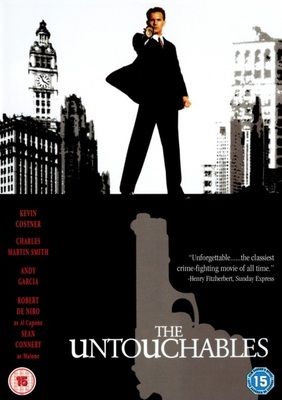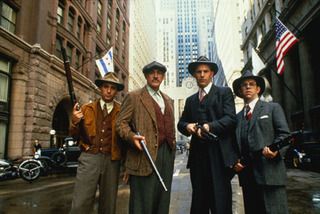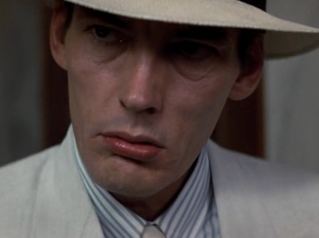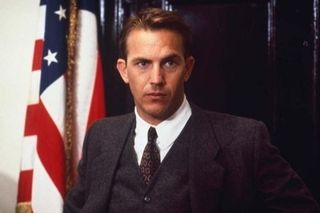The Untouchables

The Untouchables
1987
Director: Brian De Palma
Starring: Kevin Costner, Sean Connery, Robert De Niro
De Palma’s ode to the Prohibition era gangster mythology is a taut, suspenseful story that, despite his trademark wide brushes of violence, also manages to be an interesting look at daily life in the 1930s.
The story is right up there in the annals of great American folklore: Al Capone (De Niro, in full scene-chewing mode) is the Gangster King of Chicago, giving the people the booze they so crave during Prohibition. Eliot Ness (Costner) is a federal agent intent on bringing him down. Typical stakeout stuff gets him nowhere, so he assembles the classic “rag tag” group to bring down Capone. There’s the accountant (Charles Martin Smith), the sharpshooter (Andy Garcia), and most importantly, the world-weary beat cop who has seen it all and, more importantly, seems to know it all (Connery, in an Academy Award winning performance). Together, they are The Untouchables.

Obligatory group shot.
Everyone knows this story. Americans live for this type of story. Capone is revered, a legend. What is different about The Untouchables is that it is clearly told from Ness’ side. Frankly, between the two characters, Capone is far more interesting, but De Palma takes a stance; he sides with the law, regardless of how futile the Prohibition law really was. Capone may be more glamorous, but there is something to be said for Ness’ strait-laced view of The Laws of the Land. But De Palma also knows that Ness may be a little too strait-laced to be palatable, so he bends a few historical facts and brings in Malone (Connery), a beat cop on the outside, but a little mini gangster on the inside. As he constantly tells Ness, “How far are you willing to go to get Capone?” Completely in favor of fighting violence with violence (“He sends one of yours to the hospital, you send one of his to the morgue!”), he acts as the little devil on Ness’ shoulder, pushing Mr. Uptight into a down and dirty prizefight that can only be won by breaking a few rules.
A lot is made of the violence in the film, and yes, I’m going to talk about it too. I’m going to talk about it because I actually adore the way the violence is done. De Palma has a reputation as a bloody director, but the film didn’t strike me as particularly violent; it’s just done in a really, really smart way. De Palma laces the film with short, sudden staccato bursts of brutal violence, then immediately cuts away, usually to a disconcertingly normal scene of domestic life. The effect is a frightening carryover; I’m still massively wigged out at what just happened, but now I’m watching Ness read his daughter a bedtime story. It’s perfectly clear that the violence that is happening in the film has the potential to dethrone that precious domestic bliss. He also explicitly shows very little; most of the significant violence is portrayed through a cut-away shot at the very last second. Believe me, this is much more effective than actually showing the violence. What I’m imagining is far worse than anything De Palma could put on the screen, and, blessedly, he knows that.
De Palma’s direction is nothing if not ostentatious. For some, this would be annoying, but I kind of love a brazen directorial style. The opening shot of the film is a dizzying overhead view of Capone in the lap of luxury, getting his nails done, his face shaved, and his shoes polished all at once, all in an ornate hotel room, nonetheless. The camera slowly zooms in from above, playing with our sense of spatial relationships. This is not the only straight above or straight below shot in the film; De Palma comes back to it several times. He also uses deep focus camerawork in a telling scene between Ness and Malone in a church, throwing both men’s profiles into sharp relief at the same time. A frustratingly long take tracks a gangster stalking Malone through his apartment. It’s a point of view camera shot, and De Palma plays with us, bringing Malone into and out of the frame, the helpless deer in the hunter’s scope. De Palma is bold and brassy and I love it. Then there’s the climactic showdown at the train station. On its own, it’s a great set piece, but De Palma also gives a massive tip of the hat to Sergei Eisenstein’s The Battleship Potemkin (1925) and its infamous Odessa Steps sequence. As a classic film buff, it’s exciting to see a reference like that in a mainstream Hollywood film.

Creepiest badass in a film full of badasses
The weakest part of the film to me is Kevin Costner. God bless him, but the man does not have tremendous depth. Or range. And the problem is, he’s surrounded with actors who are turning in fantastic stuff. De Niro doesn’t have much to do as Capone, this definitely being more of Ness’ story. His Capone is largely symbolic, the big bad royal gangster, but you want someone to play a gangster, you get De Niro. He knows how to do gangster. He is alternatively charming and terrifyingly violent. Connery’s Malone is even more badass. As soon as he changes out of his cop uniform to join up with Ness, there is some switch that goes off for him and there is no such thing as too far. I get the feeling that Connery must have been waiting to play a character like Malone, someone so clearly unhinged, because he does it with such relish. Charles Martin Smith as the accountant Wallace is enjoyable in his expected nebbish demeanor-turned-violent lawman, and Patricia Clarkson as Mrs. Ness is, as ever, divine. Billy Drago is beyond memorable as Capone’s Angel of Death, Frank Nitti. Bedecked from head to toe in white, he leaves a violent and disturbing wake of destruction wherever he goes. With his evil smile and spine-chilling cackle, he is easily the most frightening character in the movie.
Costner is pitted against all of this. He never stood a chance.
His Ness is wooden and, frankly, a little boring. Now don’t get me wrong; perhaps Ness, as Mr. Obey The Rules is supposed to be wooden, but he also goes on an emotional journey, moving from an investigator intent on playing by the rules to one willing to do whatever it takes to bring down Capone. He does not believably make this leap. Honestly, one moment, Ness is all, “Oh, there’s no way I could do that,” and the next scene, he’s freely firing at gangsters, supposedly having unleashed some inner demons. Wait, where was the change? I missed it. Mr. Costner, would you mind rewinding a moment? I think I missed something. And given how determined Ness was at the beginning of the film to play by the rules, it would have made far more sense to end the film with a tortured Ness. He did what he had to do, but was he really okay with it? I have doubts about that. Oh, poor Kevin Costner. You really never stood a chance, did you.

This right here is his expression in 95% of the film.
All that being said, Costner’s weak link does not keep me from enjoying The Untouchables. De Palma’s film is a tremendous thriller with a great story and great performances and great visuals and great set pieces. All around, very fun moviemaking.
Arbitrary Rating: 9/10